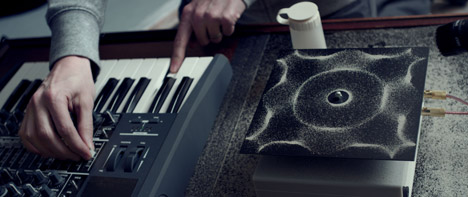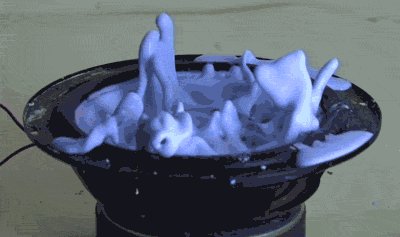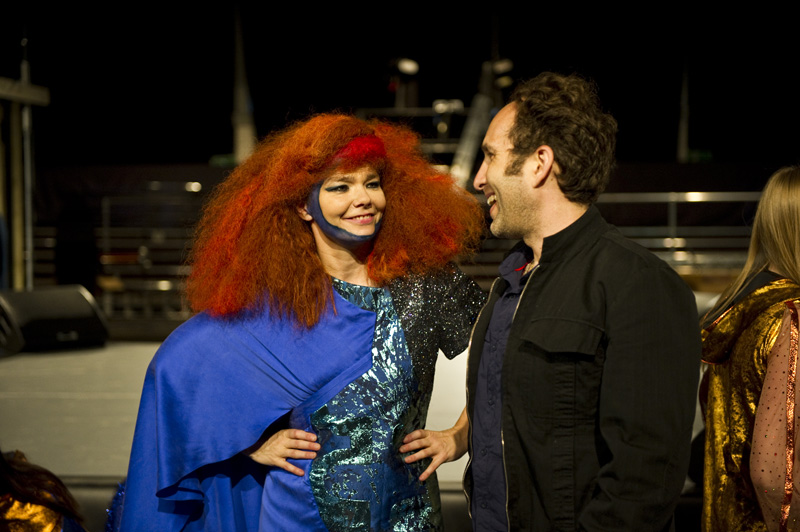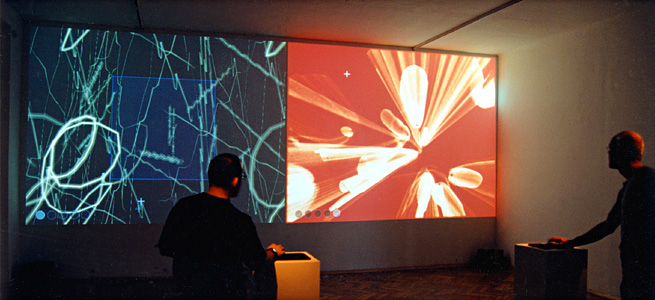

C Y M A T I C S
DANIEL BREUER AND JASPER KIRTON-WINGATE
I N T R O D U C T I O N
Jasper and I both share a common interest in the interaction between music, visuals and the various other sensory ways they can be presented together. Seeing as this is a very broad category we decided to focus our attention more towards the physical manifestation of music visualisation (cymatics) in conjunction with the digital representation through the use of an oscillator.
Oscillators convert direct current (DC) from a power supply to an alternating current (AC) signal, and when partnered with various sounds, can often display beautiful, mesmerising images. Artist Robin Fox who uses oscillators in his artwork has said that when it comes to the interaction between music and visuals, “there is no causality; the two things happen simultaneously so you don’t have time to think about which came first. Sight and sound become the same thing in time and space,” [1]
In the case of cymatics, the audio creates the visuals but rather than the output remaining digital, the product creates a physical manifestation of the music. This can be done via non-newtonian fluid on a speaker, sand on a Chladni Plate of even water in a bowl. Although the usage of cymatics and modal vibrational phenomenon is not a new discovery, “Leonardo Da Vinci noticed that vibrating a wooden table on which dust lay created various shapes” [2], using it in conjunction with art and music and performance is a relatively new thing. Contemporary artists such as Alexander Lauterwasser have brought cymatics into the 21st century by “using finely crafted crystal oscillators to resonate steel plates covered with fine sand and to vibrate small samples of water in Petri dishes.” [2] and partnering these visuals and making them even more beautiful by using various light patterns that shine on them as seen in the video below:
C Y M A T I C S R E S E A R C H
All objects have a set of natural frequencies at which they vibrate, which is what essentially causes the patterns to appear on a Chlandi Plate or in a bowl of water or whereever else one might experiment with cymatics. Because said patterns can be so mesmerising and enchanting, cymatics have often been used for art projects, performance pieces and in conjunction with music shows. Icelandic musician, Björk, teamed up with artist Meara O'Reilley and artist/developer Scott Snibbe for her world tour in 2013 to create a series of cymatic projections to accompany her show. “For this project, cymatic patterns were choreographed and synced to the basslines of songs from the album. The footage was designed to be projected on the floor so as to give the appearance that Björk stands on a large cymatic device. In some cases the projections occurred on backdrop screens” says the artist, who is based in San Francisco. [3]
Evan Grant, another cymatics artist and Björk collaborator has dubbed cymatics as a "window that reveals all these vibrations all around us that we previously could not see" [4]. The seemingly endless geometric patterns one can generate from cymatics shows why it is commonly used to display the beautiful connection between sound and visuals.
.


S C O T T S N I B B E
Scott Snibbe, founder of Snibbe Interactive, who helped with the cymatic projections for Bjork's tour, also creates various artworks which focus on the participation between sound, visuals and the audience. Snibbe often talks about the importance of interaction between art and the audience. He says "I usually portray the interdependence of beings with their environments and each other through bodily interactions. Many of my works do not function unless viewers actively engage with them—by touching, breathing, or moving—so that viewers are essential to a piece’s existence as art." [5]. Snibbe was the one who created the app that accompanied Bjorks album which attempts to bring the "immersive concert environment that includes floor projections with cymatics imagery of vibrating sand by Meara O’Reilley" [6] to the iPad and iPhone in 2011.
Snibbe also created an App for composer/musician Phillip Glass which is an interactive tour through the new REWORK_ album that remixes Philip Glass’ music. The app includes eleven interactive visulisations for the remixed songs, along with an interactive “Glass Machine” that lets people create their own music inspired by Philip Glass’ early music. The idea of interactivity is an idea we wish to explore in our project.


I N T E R A C T I O N
For our project, we would like to combine the beautiful geometic shapes one can produce with cymatics and different frequencies, but also have an element of intereaction with the audience/viewer. For this we looked at artists such as Christine Sun Kim, who has been deaf from birth yet still uses sound in her artwork. In regards to sound, she states “It doesn't have to be something just experienced through the ears. It could be felt tactually, or experienced as a visual, or even as an idea.” [7].
I believe that interaction is the essence of art and when combined with technological practices such as cymatics or oscillators, it can really elevate artwork to the next level and propel it into the 21st century. Scott Snibbe summed up this ideology when asked about the interactive nature of his artwork: "Although the ideas that my interactive art attempts to convey are complex, my artistic practice is minimalist. My working process is subtractive: removing elements until only those essential to convey a work's meaning remain. I combine this approach with the principles of phenomenology: the philosophy of how a body “thinks” through unmediated perception, rather than through reason and language." [5]
S P E C I F I C I D E A S
Idea 1:
Create a visual ‘wall of sound’ for projection with live music, to be projected behind the musical performer, where the sound is the input and the wall is perceived to be reacting to it. The virtual space could be filled with glitter, represented as a particle system, for example, and the bass frequencies cause the particles to displace from the ‘wall plane’ as if to immerse the audience.
Idea 2:
Use the principles of Cymatics with already existing dynamic fluid systems to negate the need for actual neo-Newtonian fluid, creating beautiful patterns observed in a natural environment with new realms of possibilities.


Visit this link if you would wish to view our slides for the Pecha Kucha presentation on the same topic:
https://docs.google.com/presentation/d/1VWo82db7MQCOzEOljULr0CHgDLq81RD2yXuj1CeeQAM/edit?usp=sharing
References
[1] https://monablog.net/tag/robin-fox/
[2] http://www.roelhollander.eu/en/tuning-frequency/cymatics/
[3] http://cymatica.com/2013/01/16/bjork-cymatics-collaboration/
[4] https://www.youtube.com/watch?v=TDgLAjtO9FQ
[5] http://www.snibbe.com/bio/
[6] http://www.snibbe.com/biophilia-concert-visuals/
[7] https://www.ted.com/talks/christine_sun_kim_the_enchanting_music_of_sign_language?language=en











































































